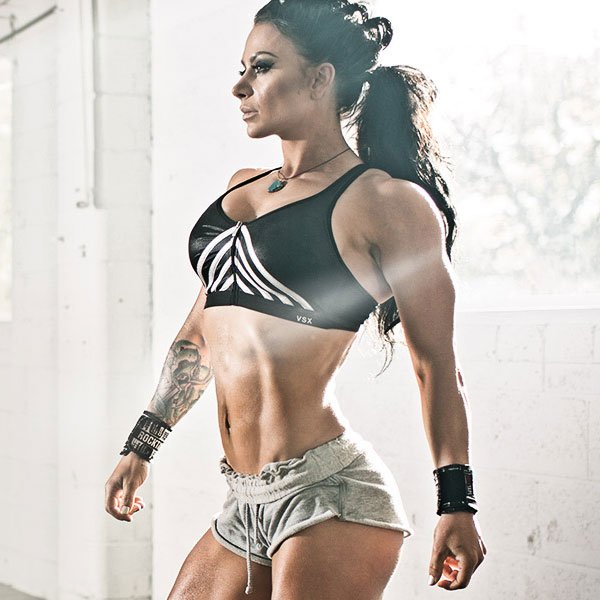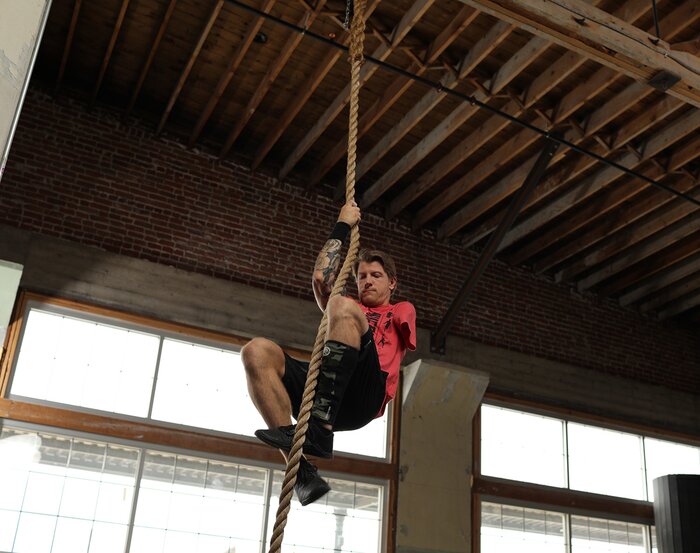Logan Aldridge knows the secret to overcoming any challenge is to adapt. He’s been doing just that since he lost his arm in a boating accident at age 13—and more recently, as he rose to be one of the most prominent athletes and advocates of adaptive CrossFit.
Thanks in large part to his efforts, Aldridge and other adaptive athletes will compete in the 2021 CrossFit Games in the newly created Adaptive Division. Bodybuilding.com caught up with Aldridge just days before the start of the Games to chat with him about what it means to have the sport he loves acknowledge and embrace the adaptive community.
You're competing in the CrossFit Games alongside other adaptive athletes for the first time. How did this shift happen, and how does it feel?
Aldridge: It's very exciting. It's something this community has been working towards for over a decade. CrossFit was adamant about being more inclusive and accessible, and there was no better time to really be bold and take this step.
It was really a golden opportunity to approach them on behalf of what we have been doing. I say "we" mean myself and other counterparts at Adaptive Training Academy like Alex Zirkenbach and Chris Stountenberg, who is also the founder of Wheel WOD. We've spent the past several years creating legitimate, safe, effective ways to train all different abilities and impairments.
CrossFit quickly realized that we already had our stuff together and were ready for the challenge.
Do you feel like you are more of an adaptive athlete or an adaptive ambassador at this point?
I'm in a weird position because I'm an athlete who plans on being competitive and participating in these events and competitions, but I'm also a director on behalf of the organization that has been consulted to implement it.
That means there's parts I get to be privy to in the beginning, and then I have to step away. All the programming and the actual workout design at the Games, I know nothing about it. That separation is important to me, because I wanted this to happen not only for other folks to have the opportunity to compete, but selfishly for myself to compete and do well.

How have the past 18 months affected your training?
In 2020, I quit my job because I wanted to focus full-time on building an adaptive training academy. Few people can go into a gym and find a trainer who knows exactly how to work with someone in a wheelchair. We host live seminars and travel around the world, educating and certifying trainers, therapists, and coaches on how to work with people with disabilities.
Well, then the pandemic hit. How hypocritical would it have been for this adaptive organization to just cancel live seminars? Instead, we spent six weeks, just nose-to-the-keyboard, making sure we could develop a practical and useful learning system online. We brought our certification course online, things started to become smoother, and I finally got to focus on training.
You recently passed a huge milestone for the single-arm clean and jerk, lifting 225 pounds over your head with one arm. That must be some kind of record.
There's no real record that I know of, or if there is, I'm just naive to it because I honestly don't really care about that stuff. At the 2019 CrossFit Games, I put 200 pounds overhead. That video was all over the Internet throughout the whole pandemic--that was wild experience for sure.

Here we are a year and a half later. I was at an adaptive qualifier in Florida and, yeah, I PR'd by 25 pounds. That was a huge surprise to me.
I had no plan to do that. It wasn't on the agenda. It was just a five-minute window to establish a max clean and jerk.
What did it feel like to put that much weight over your head on a barbell with one arm?
In weightlifting, 225 is a very iconic number—it's two 45-pound plates on each side of a 45-pound bar. I never trained to put that much weight up. I train for CrossFit which is yes, a lot of variations of conditioning and strength training, but I never had a goal to put more than 200 pounds over my head. I wasn't even sure it was possible or safe to do.
I'd hit 185 super easy right in the beginning, then did 195, then 205. I think I was running on adrenaline. I saw the weights laying there and I was just like, let's just go for it. That's me in a nutshell: I want to entertain the audience and also show what I'm capable of.
It was an incredible moment. Do you have any other strength goals or records that you're looking to break now that you've passed that milestone?
Honestly, I don't have any goals like that in CrossFit. My only goal is to address weaknesses. I'm not necessarily turning them into strengths, but training to be a well-rounded athlete. That's the only mental approach I have in my training.

CrossFit seems to favor athletes with an especially strong mental game. Why is that?
One hundred percent. When you do things that are hard, and you know no matter how well you do them, you can do better; what you're exercising is not your physical body. It's your mind. You're training your mind to endure difficult situations and to push through pain and frustration. When you come out on the other side, it's because of your mind.
That's what CrossFit does: it forges mental strength, and that's what forges athletes. Looking at this population of folks living with physical limitations, if they're interested in CrossFit, they're already mentally strong. The byproduct is our bodies get physically stronger, but what we're training, and sharpening are our minds.
This year is a huge change for CrossFit. What other shifts are happening for adaptive athletes?
I do think what we're doing is the future. We can make adaptive programs accessible and available in your brand or fitness or gym your organization wherever you are.
All of us can use fitness to improve quality of life. I think what we've done has shown that there's a tremendous benefit to continuing to move, no matter what your limitations are. I just want to show adaptive athletes—and the rest of the world—that we're all far more capable than we believe, and we can all do a bit more than we thought we could.
